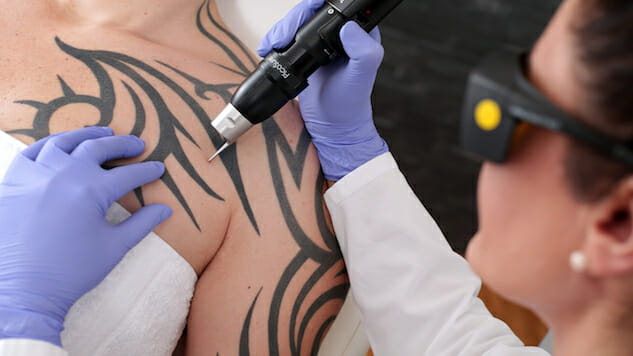The Basics of Beauty Lasers

Drugstore beauty treatments come in all shapes and sizes: gels, creams, peels, masks and more. The aisles are endless with perfection-enhancing possibilities. But when you walk into a doctor’s office for laser treatments, or use an at-home device, the list of solutions to proposed problems becomes even larger. With the ability to fix (almost) anything—from acne, to wrinkles, to unwanted hair—it might be worth strapping on a pair of goggles and getting zapped, but before you do, you should know how those little lasers actually work. Read on for the energy-filled answers (ahem, beams) to some pesky and personal complaints.
Hair Removal
Say adios to painful waxes! Instead of yanking hair out, it’s removed safely and effectively with very little discomfort via laser. In most procedures, follicles are targeted and destroyed over the course of six treatments, each six weeks apart. While no formal preparation is needed before getting lasered (read: no lotion, nada), candidates should not wax the area for two to three weeks before treatment. Each session lasts 10-45 minutes, depending on the surface area. Some redness may ensue for 10-20 minutes following, according to Christian Karavolas, owner of Romeo & Juliette Laser Hair Removal in New York City. While results last six to eight weeks, there is eventual permanent hair reduction over time. It’s best to go in during winter when the skin is not tanned (plus, who wants to waste the precious days of summer inside?). The Synchro REPLA:Y Excellium 3.4 —three lasers in one including Alexandrite (for quick treatments, light skin), Nd:YAG (for dark and tanned skin) and IPL (intense pulsed laser, for sun damage)—is FDA cleared and costs $75-$700/session.
Body Contouring
Running on the treadmill can lead to great calves, but it won’t necessarily eliminate pockets of fat. For body contouring, lasers alternate between hot and cool cycles to bring fat to a temperature where it can be permanently destroyed. Anyone with excess fat is a candidate—even individuals with healthy diets who exercise. Treatments last about 25 minutes per cycle in the targeted area, with no prep or post-treatment recovery (though food and water is recommended before going in). Two to three sessions are usually required, using SculpSure, in which patients wear a belt customized to their bodies, according Dr. Jeremy Brauer, director of clinical research at the Laser & Skin Surgery Center of New York. A day or two after the FDA-cleared procedure is performed, patients might feel like they’ve been doing crunches. Once the fat is gone, it’s gone forever. And results are usually seen around the six-week mark, with full evidence by the 12-week mark. The procedure costs $1,000-$1,500+/session.
Eye Wrinkles

For mellow nights at home, the term “Netflix and chill” might as well be changed to “laser and chill.” While you can go to a dermatologist’s office to correct eye-area wrinkles and fine lines, we are big supporters for banishing eye wrinkles from the comfort of our couch. Fractional laser technology involves microscopic laser beams pulsed into the skin to stimulate the body’s own natural renewal process, continuously rebuilding new collagen. Results are visible in as little as two weeks and best results are seen in eight when performed 30 seconds every night under each eye. Basically, as you’re scrolling through movie options, your face turns back the clock to yesteryear. Before use, makeup/sunscreen/other products should be removed. Afterward, there is zero recovery or downtime, though some may experience slight redness immediately following use. Staying home never felt so productive! Tria’s Age-Defying Eye Wrinkle Correcting Laser is FDA approved and retails $249/device.
Skin Sagging
-

-

-

-

-

-

-

-

-

-

-

-

-

-

-

-

-

-

-

-

-

-

-

-

-

-

-

-

-

-

-

-

-

-

-

-

-

-

-

-









































